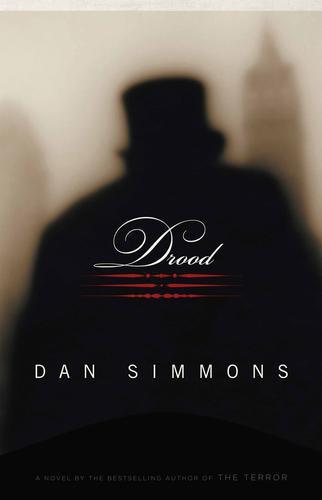
Drood
A Novel
کتاب های مرتبط
- اطلاعات
- نقد و بررسی
- دیدگاه کاربران
نقد و بررسی

Starred review from November 24, 2008
Bestseller Simmons (The Terror
) brilliantly imagines a terrifying sequence of events as the inspiration for Dickens's last, uncompleted novel, The Mystery of Edwin Drood
, in this unsettling and complex thriller. In the course of narrowly escaping death in an 1865 train wreck and trying to rescue fellow passengers, Dickens encounters a ghoulish figure named Drood, who had apparently been traveling in a coffin. Along with his real-life novelist friend Wilkie Collins, who narrates the tale, Dickens pursues the elusive Drood, an effort that leads the pair to a nightmarish world beneath London's streets. Collins begins to wonder whether the object of their quest, if indeed the man exists, is merely a cover for his colleague's own murderous inclinations. Despite the book's length, readers will race through the pages, drawn by the intricate plot and the proliferation of intriguing psychological puzzles, which will remind many of the work of Charles Palliser and Michael Cox. 4-city author tour.

December 1, 2008
A suspenseful and spooky descent into the last days of Charles Dickens, who expired before he could complete his final novel, The Mystery of Edwin Drood.
Although he doesn 't quite have the hang of Victorian prose and writes instead with modern matter-of-factness, Simmons (Muse of Fire, 2008, etc.) hits on a nice conceit at the outset, giving Dickens 's fellow novelist Wilkie Collins the job of narrating this long, shaggy dog of a tale. Collins, known today mostly for his mystery novel The Moonstone, if known at all, plays a kind of Salieri to Dickens 's Mozart, his jealousy evident: "Charles Dickens was the literary genius and I was not. " The figure of Drood first turns up at the scene of a hellish train wreck from which Dickens, 53 years old and gouty, has emerged. Drood does not cut a pretty figure, "pale eyes in their sunken sockets, " muttering unintelligibly amid the gore, but he is certainly memorable. A few score pages of preliminaries later, and Dickens is absorbed in ferreting out Droodian mysteries, rattled to discover that his necromantic quarry, "healer, master of Magnetic science, Christ figure, and secret mystic " late of Egypt, has in theory been dead for many years and that assorted cannibals, ghosts and spirit rappers figure into the grisly equation. Things get weirder still as narrator Collins nurses the various psychic wounds wrought by the recognition that Dickens, though slovenly ( "pulling characters out of the air …without a thought as to how they might serve the central purpose "), will write circles around him for as long as Dickens is alive. There are, of course, remedies for that particular problem, as readers needing a quick lesson in the chemistry of the quicklime pit will discover.
A lively entertainment, reminiscent of Nicholas Meyer 's Seven-Percent Solution —and a worthy rejoinder to Dickens 's swan song.
(COPYRIGHT (2008) KIRKUS REVIEWS/NIELSEN BUSINESS MEDIA, INC. ALL RIGHTS RESERVED.)

Starred review from January 15, 2009
Titled in reference to Dickens's unfinished novel, "The Mystery of Edwin Drood", Simmons's latest (after "The Terror") casts one grotesquethe drug-addled and paranoid Wilkie Collins, author of "The Moonstone" and "The Woman in White"to write about another grotesque, Charles Dickens, who's bursting with energy and colossal egotism, already secure in his position as England's greatest living writer. Collins becomes convinced that they are both being pursued by a vampiric mass murderer named Drood. Drood's eyelids have been excised and his teeth filed to points. He has mastered the ancient Egyptian black arts, and he leads an army of undead followers who live in the sewers and caverns beneath London. But is Drood real, or is he a phantasm of Collins's opium-filled brain? This sprawling monster of a novel is Collins-like in its exotic extravagance, Dickensian in its sharply delineated characters, major and minor. Simmons has captured to a tee the high style of late Victorian melodrama: the story line is consistently engrossing and utterly unpredictable. This rip-roaring adventure is a true page-turner. Enthusiastically recommended for all popular collections. [See Prepub Alert, "LJ" 10/15/08.]David Keymer, Modesto, CA
Copyright 2009 Library Journal, LLC Used with permission.

Starred review from January 1, 2009
Everyoneknows the name Charles Dickens, but only dedicated mystery buffs remember his friend and fellow writer Wilkie Collins. This is an injustice Collins wishes to rectify from the grave, so he reaches out to you, Dear Reader of the future, to describehis life and longings in this first-person account (ostensibly written in the 1860s for posthumous publication). Horror master Simmons makes use of his genre skill here but adds so much more. His starting point is a real event in Dickens life, his near-death when a train on which he was riding jumped the track. Dickens confides in Collins that a spectral presence named Drood appeared to aid (or perhaps kill) the survivors. Dickens becomes enthralled withsolving the mysterythat isDrood and pulls Collins into his investigation, astrange search thatleads to Undertown, a city within a city beneath London, complete with filthy catacombs and opium dens (which Collins enjoys). Sometimes the question of Droods identity seems only a MacGuffin to pull readersmore deeplyinto the relationship between Dickens and his Salieri-like frenemy Collins. Thats perfectly fine because the book is atits richest when Collins explains, justifies, curses, and lamentshis personal and professional association with his celebrated fellow writer.What makes Collins (and his changing views of Dickens) so fascinating is his perplexing unreliability: readers never know if his observations are his own or products of drug-induced projections. Simmons also offers a stunning re-creation of Dickens London and its charactersthats almost as good as, well . . . Dickens. A top-notch, genre-bending tourde force, this is where history and horror meet.(Reprinted with permission of Booklist, copyright 2009, American Library Association.)

























دیدگاه کاربران